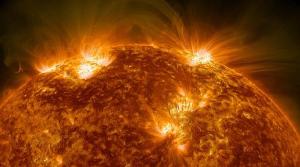Post
Solar Wind
7 June 2012
 NASA/Goddard/SDO
NASA/Goddard/SDOIn the early 1900s, there was observational evidence of a connection between the appearance of solar flares and the later appearance of intense aurora displays and geomagnetic disturbances. The average delay times were on the order of 1.5 days so it was established that material from the sun was shooting out into space at high speed. It was seen that the flare area and associated sunspot region had be centrally located with respect to the earth or the material would miss the earth entirely.
But as polar region auroral and magnetic monitoring became more routine, it appeared that aurorae and minor magnetic disturbances occurred around the clock in most high latitude locations, and regardless of season and stage of solar activity. This meant there must be some lesser streaming of material from the sun all the time. Initially the composition of the material responsible for these weak emissions could not be readily be determined, but we knew it had to involve streams of charged particles because otherwise the aurorae were concentrated at the geomagnetic poles. We now know this phenomena as the solar wind, which is a nearly continuous stream of ionized hydrogen that flows outward at high speed from the sun, creating the heliosphere.
Within most of the solar system the solar wind actually moves at supersonic (that is the speed of sound in the stellar plasma) speeds. But eventually it starts interacting with interstellar gas and slows down to subsonic speeds. The point where this transition occurs is known as the termination shock. It was generally thought that termination shock must be located about 100 AU (100 times the distance from the Earth to the Sun), and roughly spherical. Of course we didn’t really know for sure until 2004 when Voyager I reached the terminal shock at about 90 AU. But then in 2007 Voyager II reached the termination shock at about 75 AU. This meant that even though the solar wind appeared to stream out in all directions, the shape of the termination shock might not be spherical.
Most recently a satellite called the Interstellar Boundary Explorer (IBEX) has been studying the solar wind and termination shock, and through it we’ve discovered things are a bit more complicated than we imagined. One of the more surprising findings is that the heliosphere is not generated entirely by the Sun. There is also a stream of neutral hydrogen atoms coming from interstellar space. The interaction between this stream and the solar wind affects the location of the termination shock boundary.
As far as our understanding of the solar wind is concerned, things are starting to get very interesting.